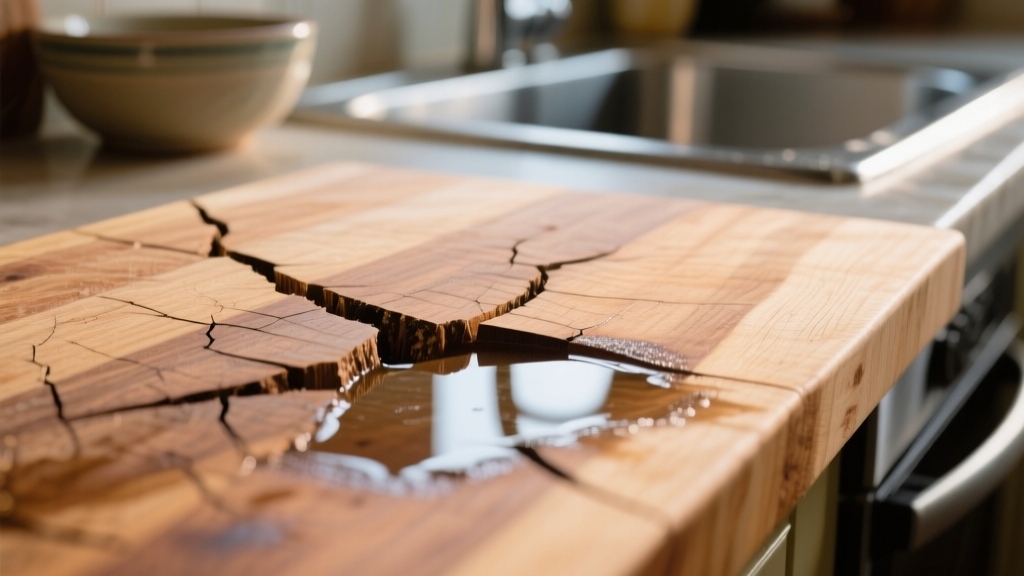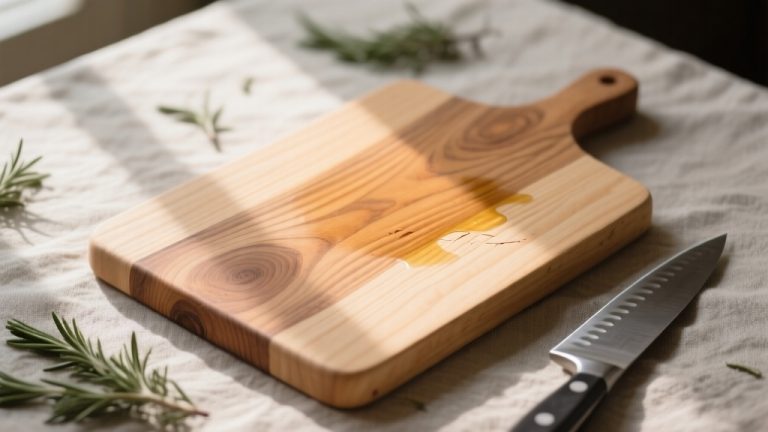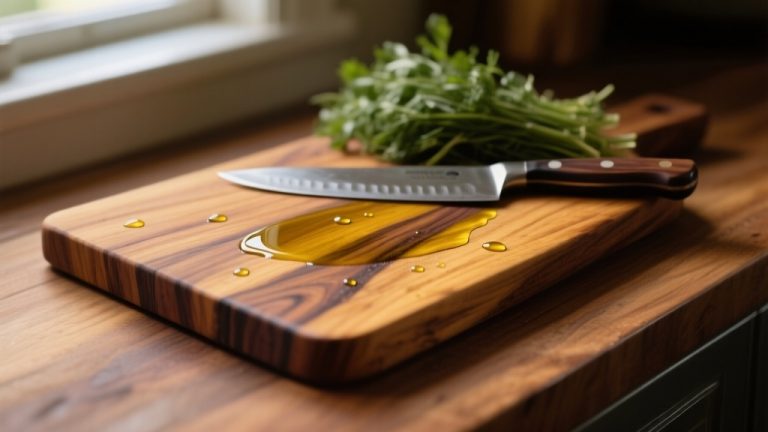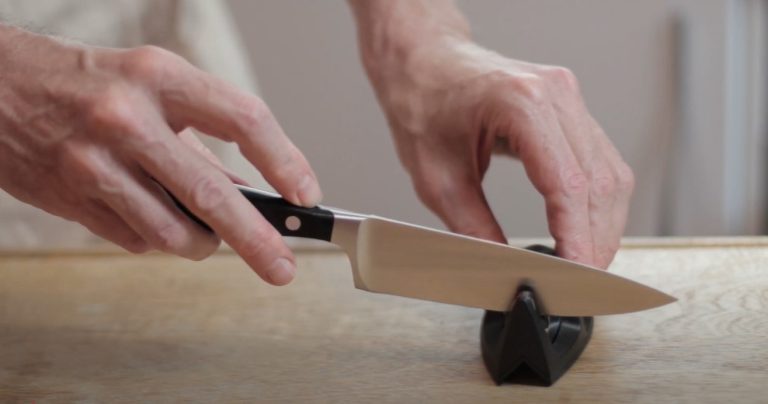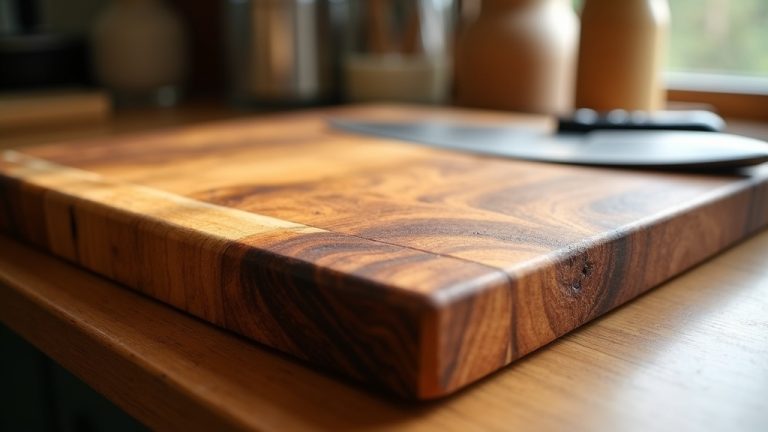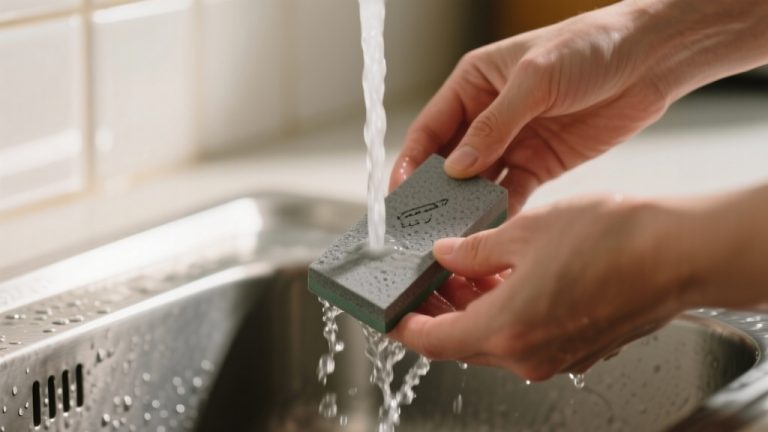Why Is My Boos Block Cracking: Prevention & Repair Guide
Your Boos block is cracking because uneven moisture loss causes wood fibers to shrink and split, especially if it’s not properly oiled or sealed.
Over- or under-oiling can dry out or saturate the wood, leading to brittleness or swelling.
Environmental shifts in humidity and temperature also induce expansion and contraction cycles that stress the wood.
Mechanical impacts and improper cleaning worsen damage.
Understanding these factors will help you protect and repair your block effectively.
Key Takeaways
- Rapid drying and uneven moisture loss cause wood shrinkage, leading to splits and cracks in Boos Blocks.
- Inadequate or improper oiling weakens wood fibers and accelerates drying, promoting cracking.
- Fluctuations in humidity and temperature cause wood expansion and contraction, resulting in stress cracks.
- Mechanical impacts from heavy chopping create micro-cracks that can propagate into larger splits.
- Storing the block in direct sunlight or near heat sources accelerates drying and surface brittleness, causing cracks.
Common Causes of Cracking in Boos Blocks
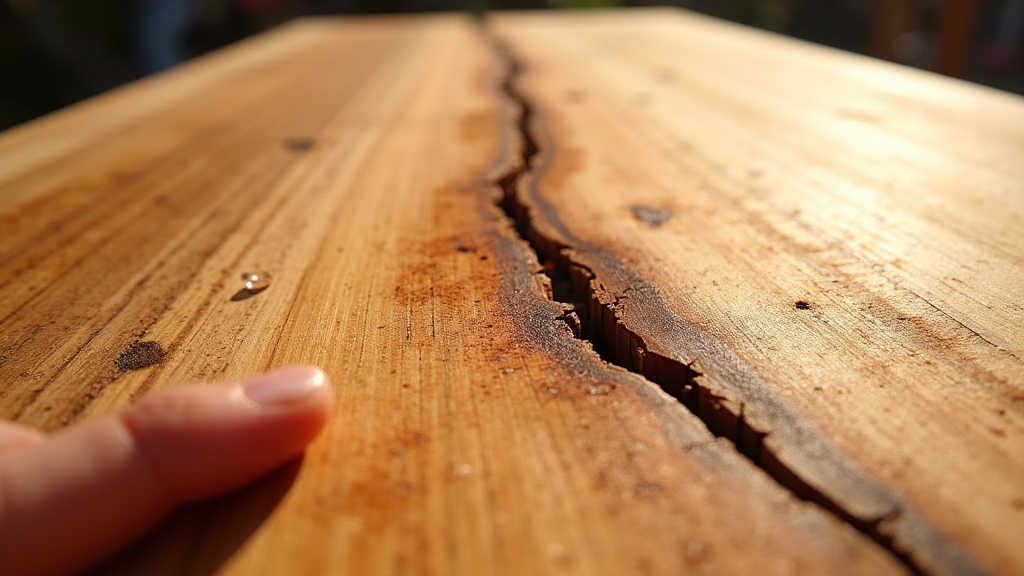
When you notice cracks forming in your Boos block, it’s often due to several underlying factors related to moisture imbalance, improper sealing, environmental conditions, mechanical stress, or material quality.
Rapid drying causes wood shrinkage and splits, especially if moisture remains trapped unevenly after washing. Inadequate sealing accelerates moisture loss and fiber delamination, promoting cracks, particularly when edges or one side are left unprotected.
Improper sealing can also allow liquids to seep in, causing the wood to expand and crack over time, which is a key cause of cracks. Regular maintenance and sealing help preserve the wood’s corrosion resistance and durability.
Environmental shifts in humidity or temperature induce expansion and contraction cycles, stressing the wood grain. Mechanical impacts, like repeated heavy chopping or improper cutting techniques, generate localized micro-cracks that propagate over time.
How Improper Oiling Leads to Damage?
Although proper oiling is essential for maintaining your Boos block, using incorrect oils or neglecting regular application can accelerate wood deterioration.
Applying cooking or vegetable oils leads to rancidity, sticky residues, and trapped contaminants that degrade wood fibers.
These oils fail to penetrate properly, leaving wood vulnerable to drying and cracking.
Insufficient oiling causes moisture loss, fiber brittleness, and microcracking.
Over-oiling traps moisture, weakens joints, and induces uneven swelling.
Applying oil without cleaning or sealing the surface compromises absorption and protection, increasing cracking risks.
You must also refinish cut surfaces promptly to prevent accelerated drying.
For ideal preservation, use mineral oil or Boos-formulated products, apply thin, even coats regularly, and seal with Board Cream to maintain moisture balance and structural integrity.
Neglecting these practices leads to visible, worsening cracks. Regular maintenance routines, similar to proper knife sharpening techniques, help extend the life and functionality of your wooden kitchen tools.
Environmental Factors That Affect Wood Integrity
Maintaining proper oiling practices helps protect your Boos block from internal damage. However, environmental conditions play an equally significant role in wood integrity. Using sharpening tools like the Intelitopia Complete Knife Sharpening Stone Set can help maintain the edges of your kitchen tools, reducing the need for harsh cutting that might otherwise stress the wood surface.
Temperature fluctuations cause wood to expand and contract, generating internal stresses that promote cracking. Rapid thermal changes accelerate moisture movement, increasing splitting risk, especially at high altitudes with greater UV exposure.
Wood expands and contracts with temperature changes, creating stresses that increase cracking and splitting risks.
Humidity variations induce cycles of swelling and shrinking. Low humidity below 20% causes rapid drying and uneven shrinkage, leading to surface tension and checks. Additionally, choosing sustainable furniture options can help mitigate environmental impact while preserving wood quality.
Prolonged sunlight exposure degrades finishes and lignin, making wood brittle and vulnerable to splitting. Additionally, wood species characteristics influence susceptibility.
Softwoods absorb moisture unevenly, while grain orientation affects moisture redistribution. Understanding these factors helps you manage environmental stressors and maintain your Boos block’s dimensional stability, reducing cracking potential.
Identifying Different Types of Cracks
Since cracks in your Boos block can arise from various causes and manifest differently, identifying their types is crucial for determining the appropriate response.
You need to distinguish between surface cracks, internal splits, and cracks caused by decay or warping. Each type impacts the block’s durability and requires specific attention.
Surface and Through Cracks: Checks are lengthwise surface cracks caused by rapid drying. Splits penetrate fully, weakening the board structurally. It is important to note that moisture presence is essential for the development of certain types of wood decay, which can exacerbate these cracks. Similar to how moisture affects knife blade maintenance, controlling environmental moisture is key to preserving wooden tools and surfaces.
Internal Cracking: Shakes and honeycombing form inside the wood, often undetectable until cutting. This reduces strength. Understanding internal damage is as critical as recognizing blade construction differences like those between Bunka and Nakiri knives.
Warping-Related Cracks: Bow, crook, cup, and twist deform the board’s shape. This causes stress cracks due to uneven moisture loss and fiber shrinkage. If left untreated, such moisture-related damage can promote fungal growth leading to wood rot that further compromises the block’s integrity.
Effective Repair Methods for Your Boos Block
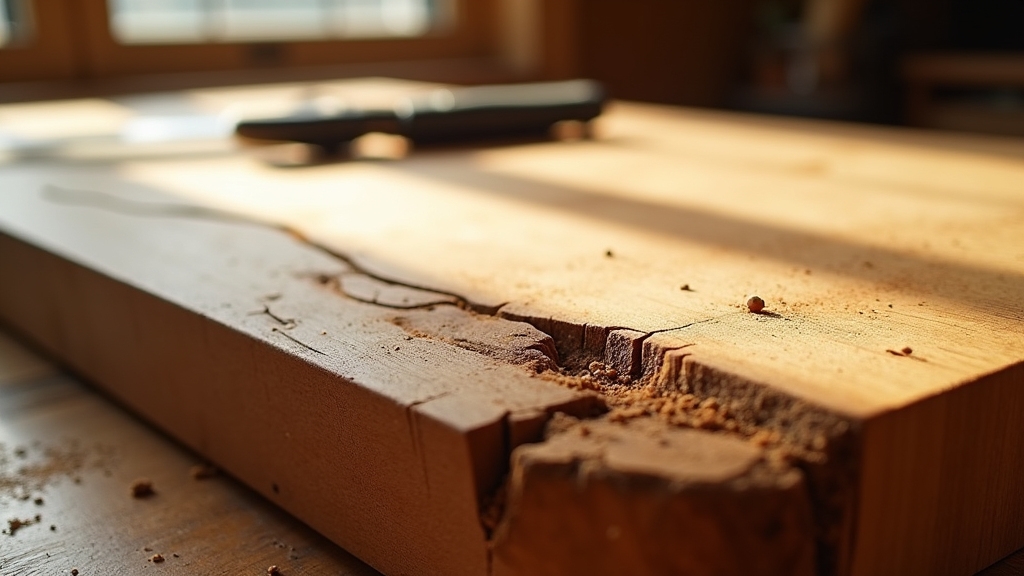
When addressing cracks in your Boos block, selecting the right repair method depends on the crack’s severity and location. For deep cracks, apply viscous epoxy over the crack after taping the area. Then use suction to draw epoxy into the fissure.
Clamping the board flat to ensure joint closure during curing is important, as it prevents further damage by maintaining proper alignment. Clamp the board flat to ensure joint closure during curing.
Once cured, scrape and sand with 220-grit paper before refinishing with oil or varnish. It is important to avoid standing water under the board to prevent further internal damage.
Minor surface cracks benefit from sanding with fine grit, always following the grain, then applying specialized cutting board oil.
For drying-related cracks, repeated mineral oil soaks can rehydrate fibers and reduce visibility. Avoid heat or moisture treatments on severe cracks, as these can worsen damage.
Tips for Preventing Future Cracks
Repairing cracks in your Boos block restores its function, but preventing new cracks takes careful attention to how you treat and store the wood. To maintain structural integrity, you must regulate moisture exposure, cleaning methods, and environmental factors precisely.
Apply food-grade mineral oil evenly every month and follow with a beeswax-based Board Cream to seal moisture without oversaturating, which can degrade fibers. Regularly re-oiling and maintaining the board not only hydrates the wood but also extends its lifespan by protecting against drying and cracking regular oiling. Be sure to apply sealants with the grain of the wood to avoid surface scratches and ensure even absorption.
Store the block upright in a dry, ventilated area, away from direct sunlight, heaters, or excessive humidity fluctuations that cause expansion and contraction.
Clean gently using mild soap and water sparingly, drying immediately, and avoid harsh abrasives. Avoid submerging the board in water or using high-temperature drying methods to maintain wood integrity.
Best Practices for Maintaining Your Boos Block
Although maintaining a Boos Block demands consistent effort, following precise cleaning, drying, and oiling routines markedly extends its lifespan and preserves its structural integrity.
You must clean thoroughly with mild soap, dry immediately, and oil regularly to prevent cracking. Avoid harsh detergents and prolonged moisture exposure.
Use a steel scraper or spatula throughout the day to maintain cleanliness, as scraping removes approximately 75% of liquids from the surface. Regular inspection and maintenance are essential to prevent damage, similar to blade inspection routines used for other kitchen tools.
| Maintenance Aspect | Best Practice |
|---|---|
| Cleaning | Use mild soap, warm water; avoid soaking |
| Drying & Storage | Towel dry immediately; store upright, ventilated |
| Oiling | Apply mineral oil monthly; use board cream quarterly |
| Avoidance | No hot pots, harsh chemicals, or standing water |
| Deep Cleaning | Use salt-lemon scrub for stains; sand if needed |
Frequently Asked Questions
Can Using the Wrong Cutting Techniques Cause Boos Block Cracks?
Absolutely, using improper cutting techniques can increase your Boos Block cracking risk by over 30%.
When you twist or scrape your knife instead of cutting straight down, you stress the wood fibers and glued joints unevenly.
Repeatedly chopping in the same spot weakens grain integrity, causing micro-cracks to expand.
Adopting precision cutting and regularly rotating your cutting areas markedly reduces structural damage and extends your block’s lifespan.
Does the Wood Species Affect the Likelihood of Cracking?
Yes, the wood species directly affects cracking likelihood. Denser, harder woods like maple resist dents but may crack from internal stress. Softer woods flex more, reducing cracks yet denting easily.
Grain structure, moisture shrinkage rates, and mechanical strength vary by species, influencing stress distribution and crack formation. Choosing species with uniform grain and balanced shrinkage improves dimensional stability, lowering cracking risk in your Boos block under typical use conditions.
Are Boos Blocks Prone to Mold or Mildew Inside Cracks?
Yes, your Boos Block can develop mold or mildew inside cracks.
Wood’s porous structure traps moisture, especially if sealing is compromised or oiling isn’t routine.
Organic residues combined with dampness create an ideal environment for microbial growth.
To prevent this, you need to maintain proper sealing, apply food-grade mineral oils regularly, clean thoroughly with mild soap, dry immediately, and ensure good air circulation.
Neglecting these steps increases mold risk inside cracks.
How Long Does It Take for Cracks to Appear on a New Boos Block?
Cracks on a new Boos Block typically appear within a few months to a year.
The exact timing depends on factors like exposure to moisture, drying practices, and maintenance frequency.
If you don’t oil the board regularly or expose it to thermal shocks, cracks can develop sooner.
High usage without rotating cutting areas also accelerates cracking.
Proper care, including monthly oiling and prompt drying, helps delay crack formation considerably.
Can Food Stains or Acidic Ingredients Worsen Cracks on the Block?
Can food stains and acidic ingredients really worsen cracks on your Boos block? Yes, they can.
Acidic substances chemically dissolve the cement matrix, etching and weakening the surface, which makes cracks more pronounced.
Organic acids from food can penetrate porous areas, deepening and discoloring cracks.
If you don’t clean spills promptly and use harsh acids or improper methods, you accelerate deterioration.
To protect your block, use pH-neutral cleaners and seal the surface after thorough cleaning.
Take Action Now: Stop Your Boos Block from Cracking Further
If you want your Boos block to last a lifetime, addressing cracks promptly is non-negotiable. Ignoring them is like inviting a wood disaster of biblical proportions.
By understanding causes from improper oiling to environmental stress and applying precise repairs, you’ll preserve its structural integrity.
Consistent maintenance and correct oiling routines are your best defense against future damage. Stay vigilant, and your Boos block will remain a reliable kitchen tool rather than a cracking headache.

